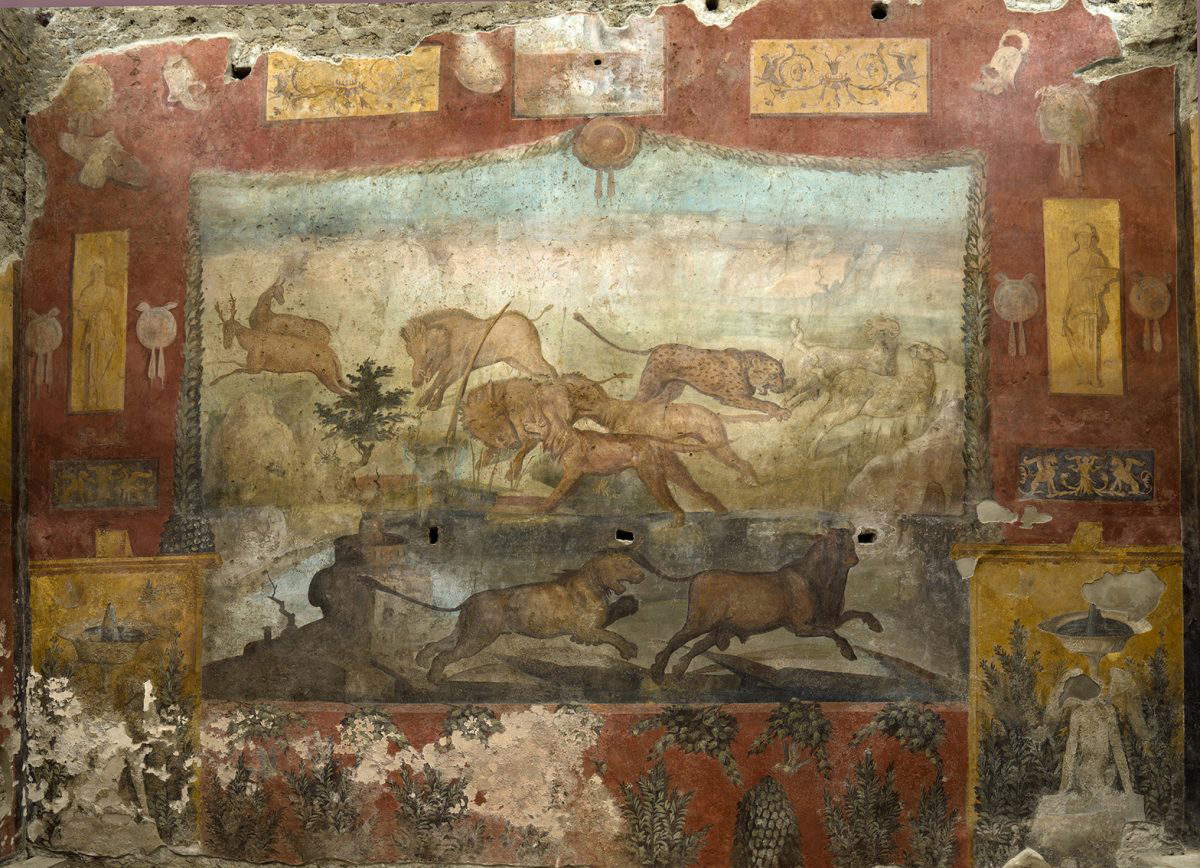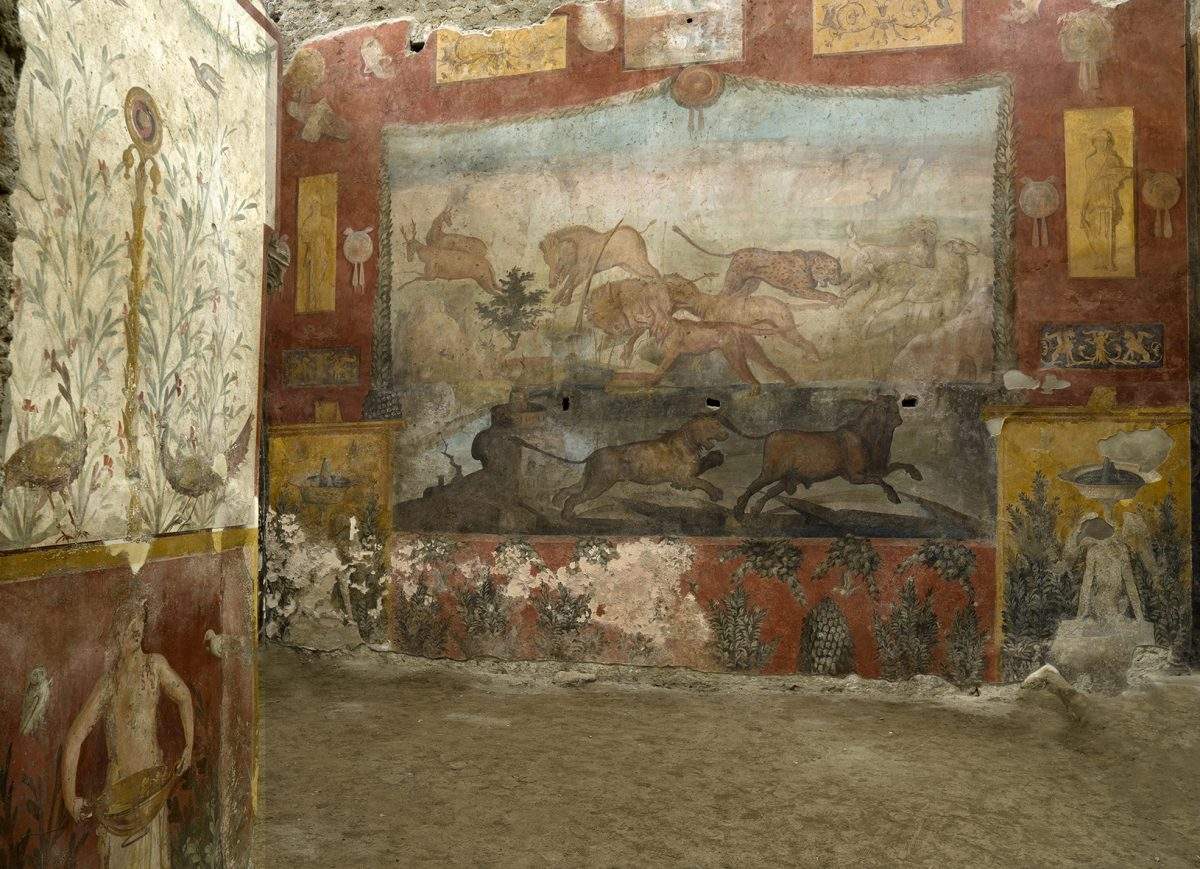In Pompeii, the restoration of the large fresco decorating the back wall of the viridarium (garden) of the House of the Ceii is finished. It is a depiction of a hunting scene with wild animals, executed against the background of a landscape reminiscent of Egypt, complete with animals from the Nile Delta depicted on the side walls. These were often recurrent subjects in the decoration of the perimeter walls of Pompeian gardens. In this case, in all likelihood, according to experts at the Pompeii Archaeological Park, the theme of the paintings also testified to a specific connection and interest that the owner of the domus had for the Egyptian world and the cult of Isis, which was particularly prevalent in Pompeii in the last years of the city’s life.
 |
| The fresco with the hunting scene |
Over the years, due to the lack of proper maintenance and allutilization of unsuitable restoration practices, there has been a gradual deterioration of the paintings and consequent damage to the frescoes, especially in the lower parts where lumidity has the greatest influence. The complex restoration intervention directed by Stefania Giudice (director of works), Luana Toniolo (director of operations archaeologist) and Raffaella Guarino (director of operations restorer) and conducted by the company RWS of Padua, consisted of a cleaning of the pictorial film also through the use of laser, which allowed to clean important portions of the painting, especially in the part of the botanical decoration of the fresco. The abraded parts of the painting were restored through a pictorial retouching operation. The entire room was closed to prevent, for the future, infiltration of rainwater and properly preserve the area. The intervention was carried out with ordinary funds from the Pompeii Archaeological Park.
“When we were able to begin this intervention there was a rather serious situation to deal with,” explains Stefania Giudice, “particularly with regard to the lower parts of the fresco, those most prone to degradation phenomena, such as the capillary rise of water, which, dragging with it the soluble salts that produce efflorescence on the pictorial film, produces very serious and also, unfortunately, definitive damage. In particular, the most difficult interventions to be carried out were first of all consolidation, because there was a series of detachments a bit at all levels of the plaster stratification and also at the level of the pictorial film, but then above all cleaning, because there were also very tenacious deposits on the surface of the pictorial film, so both chemical and mechanical cleaning interventions had to be done. In the end we also had to resort to the use of lasers because only in this way we were able to recover portions especially in the lower part, but not only that, also on the hunting scene where there were overgrown substances that resisted any kind of intervention. So we were able to recover a large part of this botanical decoration that was on the base of the fresco, which before was really barely legible and complitely obliterated by these overlying deposits.”
 |
| The fresco with the hunting scene |
The House of the Ceii, excavated between 1913 and 1914, represents one of the rare examples of an ancient dwelling of the late Samnite age (2nd cent. BCE). Ownership of the domus was attributed to the magistrate Lucius Ceius Secundus, based on an electoral inscription painted on the exterior elevation of the house. The facade of the domus, with its white stucco paneling and high portal crowned by cubic capitals, exemplifies the severe appearance that a mid-level house must have had in late Samnite times (2nd cent. BCE). In the center of the peculiar tetrastyle atrium is the delimpluvium basin, made with fragments of amphorae placed in a cut pattern, according to a technique widespread in Greece but which Pompeii finds only one other comparison in the house of the Ancient Hunt.
In past years, the domus had been the subject, as part of the Grande progetto Pompei, of upgrading, rainwater regimentation and maintenance of the roofs, which had become necessary due to a progressive loss of functionality of the same. A degradation that was exposing the rooms below, characterized by ornate plasterwork and fine floors, to a serious risk of deterioration. In the house, part of the original furnishings of the dwelling had been repurposed, with the relocation of the marble table and the well vera in the atrium, where a cast of a cupboard and a cast of the house’s entrance door is also visible. While a small domestic millstone is visible in the kitchen.
 |
| Pompeii, restoration completed on the large fresco in the viridarium of the House of the Ceii |
Warning: the translation into English of the original Italian article was created using automatic tools. We undertake to review all articles, but we do not guarantee the total absence of inaccuracies in the translation due to the program. You can find the original by clicking on the ITA button. If you find any mistake,please contact us.